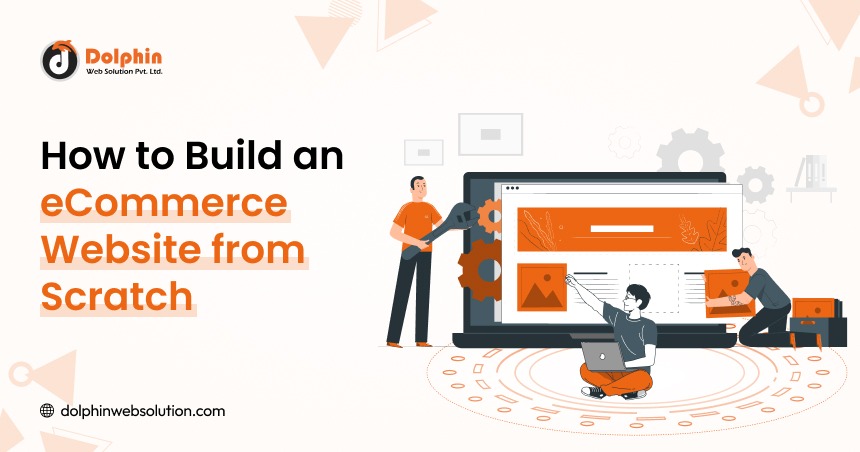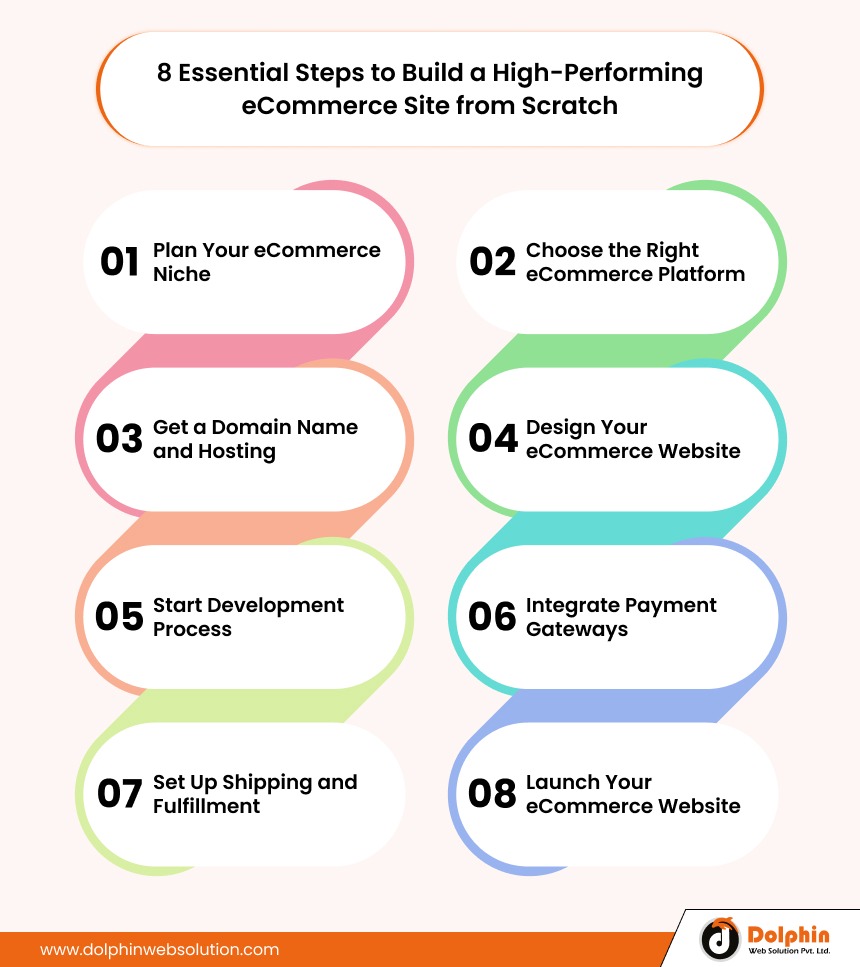How to Build an eCommerce Website from Scratch?

Table of Contents
Summary :
Besides saving time, energy, and effort, online shopping allows customers to access products from different brands under the same roof. This has opened diverse opportunities for businesses. However, building an e-commerce website from scratch needs strategic planning and execution. In this blog, let's explore the process in detail.
Introduction
Building an e-commerce website is the most crucial step in starting your online business. There are a lot of factors you need to take care of, especially if you are starting an e-commerce website from scratch. You must consider the niche of your store, choose the right e-commerce platform, get domain and hosting, and develop the entire store.
That’s a lot of work, we agree. As a businessperson, you may not understand all these steps and processes deeply. That’s why, in this blog post, we discuss the entire process of building an e-commerce website for your business.
This blog post will help you understand the process, even if you hire an e-commerce website development agency to work on the project.
Let’s start.
8 Essential Steps to Build a High-Performing eCommerce Site from Scratch

Let’s discuss eight vital stages of building a top-notch and user-friendly e-commerce website from scratch here.
1. Plan Your eCommerce Niche
While this is not a website development step per se, it is vital to pick your niche, as your later decisions will stem from this decision.
The platform you choose, the design and development choices, technologies, etc., will be affected by your choice of the niche. Hence, before you start working on anything, nail down your niche first.
However, if you already have an offline store or business, you don’t need to do this. If you do not have one, here are a few elements to keep in mind.
- Research market demand using Google Trends, social media, competition, etc.
- Define your ideal customer to understand their choices, pain points, and more.
- Pick a niche where you can make consistent profits after business expenses.
- Look for a niche with low competition but good demand among customers.
- Choose a niche where you have reliable sources for quality products.
- Pick a niche where you have the opportunity to expand and grow.
2. Choose the Right eCommerce Platform
After choosing the niche, the next step is to decide the e-commerce platform you are going to use. There are several e-commerce platforms that you can use.
Here are some of the best e-commerce platforms and their unique characteristics.
1. WooCommerce
WooCommerce is the biggest e-commerce platform in the world, with a market share of 66.44%. There are diverse factors that make it a popular choice for online businesses.
Some of the key reasons are given below.
1. As an open-source platform, WooCommerce allows extensive customization.
2. It is easy to use WooCommerce with WordPress to build an online store quickly.
3. You can use various WordPress plugins and extensions with WooCommerce.
2. Shopify
Shopify is the second most used e-commerce platform. It brings diverse e-commerce capabilities, features, and reporting features to its sites.
The following elements make it a great choice to create any e-commerce store.
1. Shopify is scalable and supports growth without needing to switch platforms.
2. Shopify enables users to set up and manage their online stores with ease.
3. Tools for payment processing, inventory management, and marketing.
3. Adobe Commerce (Magento)
Adobe Commerce (formerly Magento) is a top e-commerce platform small and large businesses use.
Let’s check out some features of Adobe Commerce
1. Magento is known for its flexibility and customization options.
2. You get access to a large community of developers and users with Magento.
3. It offers diverse features to support large product catalogs and traffic volumes.
3. Get a Domain Name and Hosting
The next step is to get a domain name and hosting for your website. If you are wondering what they are, here is a quick explanation.
1. Domain name
A domain name is the unique address people type into their web browser to visit your website. Think of it as the online ‘home address’ of a website.
For instance, in www.example.com, ‘example.com’ is the domain name. If your name is Apex Shoes, then www.apexshoes.com will be your website address. And apexshoes.com will be your domain address.
You need to buy this from any of the top domain sellers, such as GoDaddy, Namecheap, Tucows, etc., which are among the top places you can buy a domain.
2. Hosting
After creating the website, you need a place to save the design, multimedia, and code files on the internet. Hosting helps you do that by keeping the files in large computers and making them available upon users’ requests.
It is like renting a room to keep your stuff. In hosting, the rented place is online and accessible only via your domain name.
Some of the best web hosting companies you can buy hosting services from are GoDaddy, Amazon Web Services, etc.
4. Design Your eCommerce Website
At this stage, you actually start the process of developing your e-commerce website. One of the most significant advantages of developing an e-commerce website from scratch is that you can design the site exactly as you want.
In this stage, you need to work with an e-commerce website designer to put together a website that your users will love. Besides making the site beautiful, your focus should be on providing the best user experience to your users.
Here are a few key elements to keep in mind when designing your site with respect to user experience.
1. Ensure your website is optimized for mobile devices, as a large number of users browse on their phones.
2. Create a fast-loading site by optimizing images, using efficient code, and utilizing caching techniques. Slow sites make users leave.
3. Ensure your site has an intuitive navigation with clear labels, organized menus, etc., to help users quickly find what they need.
4. Maintain a consistent style across all pages by using the same colors, fonts, and button styles to deliver a consistent user experience across the store.
5. Add elements to build trust among your audience, such as product reviews, customer testimonials, trust logos, etc.
5. Start Development Process
In this stage, you start the development process. There are several ways to do this. If you have an e-commerce development team, you can use the internal team. Hiring an experienced e-commerce development agency, like Dolphin Web Solution, is the best way if you do not have an in-house team. The development stage often decides the time taken to build an e-commerce website.
There are two approaches to developing your e-commerce store.
The first one is to choose the default or free theme provided by the platform you choose. This can make your job faster and easier.
However, default or free themes may have limitations, such as given below:
- Pre-built themes offer limited customization capabilities.
- Many default themes have unnecessary features and plugins.
- Often, support for free themes is very limited or cannot be found.
- Free themes may not be regularly updated, leading to security issues.
The next option is to customize the theme with the help of an e-commerce developer with the e-commerce website features you want. If you have the resources to do that at the initial stage and are planning to grow, this is the best option for you.
6. Integrate Payment Gateways
After developing the website, the next option is to integrate a payment gateway into the store. Payment gateways enable you to process payments from your customers online. They need to be highly secure to not just ensure the safety of the payments but also to make sure that the payments go through. Also, payment gateways are a crucial element that can drive up the e-commerce website cost. Hence, never compromise it by going for cheaper options.
There are several payment gateways that you can use. Here are a couple of things you need to keep in mind when choosing a payment gateway.
1. Assess all associated fees, including setup, monthly, and transaction fees.
2. Ensure that it complies with PCI DSS standards and offers robust fraud detection tools.
3. Consider the payment options offered, such as credit/debit cards, digital wallets, and international payment methods.
4. Ensure it integrates with your existing e-commerce platform and other business tools.
5. Look for a provider that offers reliable customer support through various channels.
7. Set Up Shipping and Fulfillment
Now, this is one of the most important aspects of running an e-commerce store successfully. Without proper and timely shipping and fulfillment, it is hard for any e-commerce store to become a success.
You can set up different types of shipping methods for your customers depending on various factors, such as their membership, amount of purchase, how often they buy from you, etc. This is also the stage where you decide whether you want to charge shipping charges from your customers.
Along with these elements, inventory management and returns and exchanges must be decided here, as well. All these elements work together to create a seamless shipping experience for you while your customers can enjoy faster delivery.
8. Launch Your eCommerce Website
Now is the time to launch your e-commerce website. Once you have checked and assessed the performance of your store, you can launch it. Before launching, it is vital to add your products to your store.
Before making the website live, test the following factors:
1. Mobile responsiveness for a better mobile shopping experience.
2. Payment gateway functionality to ensure secure transactions.
3. Page load speed on diverse devices for faster performance.
4. Product search and filters to help users find items quickly.
5. Your checkout process and multiple payment methods.
Once you have checked all these factors, launch your website.
Conclusion
Creating an e-commerce website is a time-consuming task. You need to focus on various elements, such as site performance, user experience, secure payments, accurate fulfillment, etc., while developing an e-commerce website. While you may be able to do it by using the default e-commerce platforms and online website builders, they may not perform as well as you expect. That’s why it is smart to work with an expert like Dolphin Web Solution to build e-commerce websites from scratch.
Dolphin Web Solution has been at the forefront of offering top-notch and customized e-commerce development services for businesses of different sizes and scopes. And if you want to work with a reliable agency for faster store launch, contact our client support now.
Get free e-commerce development consultation.

Hello!
Click one of our contacts below to chat on WhatsApp

